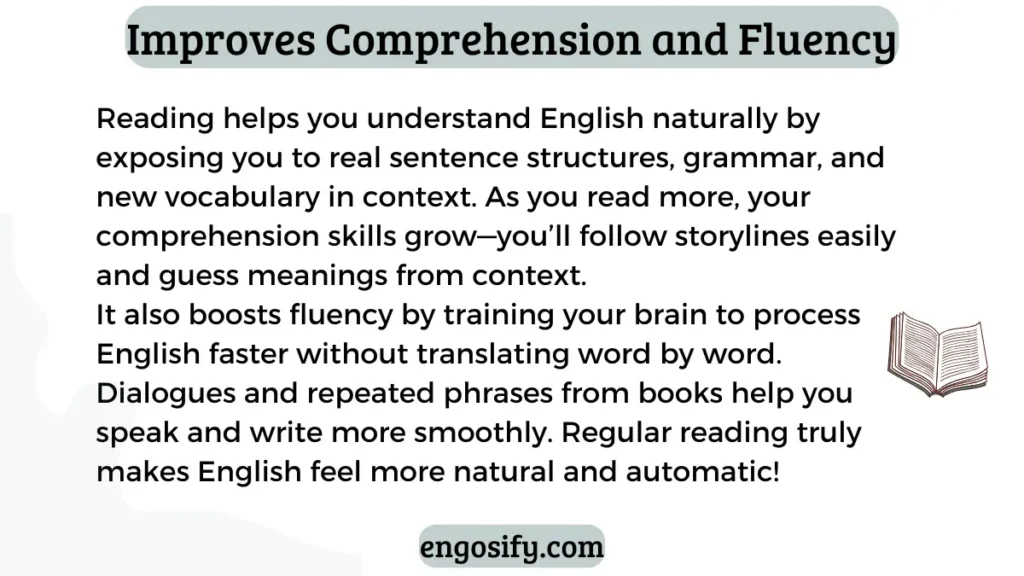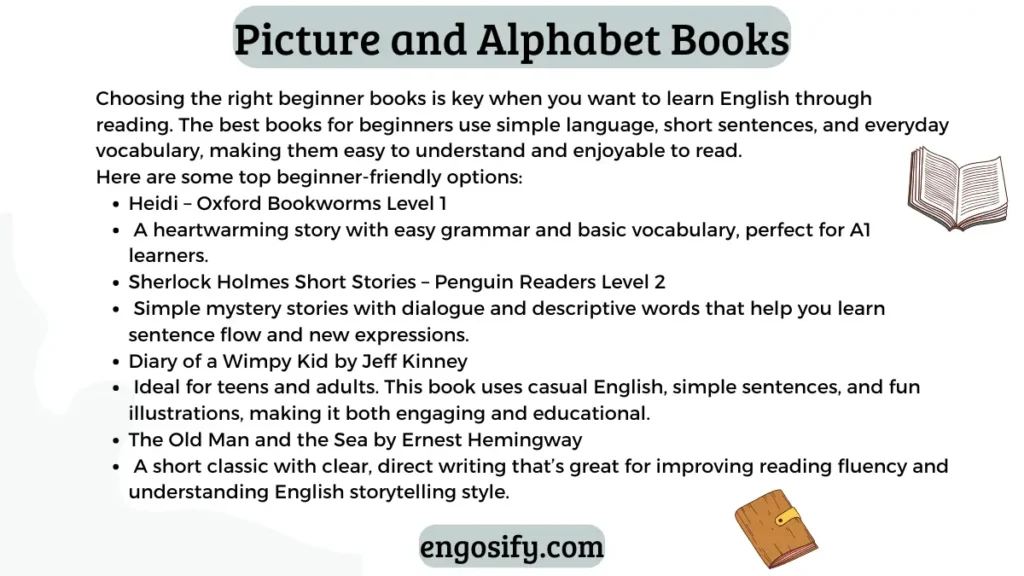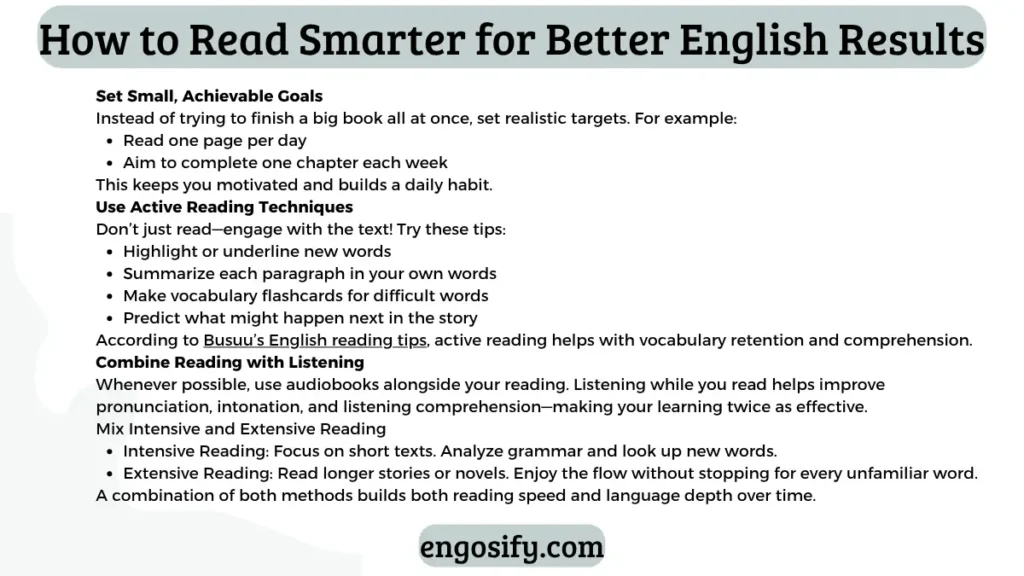Introduction
Learning English doesn’t have to be boring or stressful. In fact, one of the easiest—and most enjoyable—ways to boost your skills is to learn English through reading. Whether you’re just starting out or you’ve been studying for a while, reading the right kind of books can help grow your vocabulary, improve your grammar, and build your overall fluency faster than you might think.
In this article, we’ll dive into why reading is such a powerful tool for language learning, how to choose the perfect beginner books, and we’ll even give you a carefully selected list of the best books for English beginners. Plus, you’ll get practical tips and answers to common questions from other learners just like you.
So grab your favorite reading spot, and let’s jump right in!
Why Reading Is the Perfect Language Learning Tool
Learning English can sometimes feel like climbing a mountain. But what if I told you there’s a more relaxed—and even fun—way to improve? Yep, it’s reading!
Reading isn’t just about flipping through pages and recognizing words. It’s a full-on brain workout that introduces you to new vocabulary, sentence structures, and idioms—all without you even realizing it.
Reading Builds Vocabulary Naturally
First off, when you learn English through reading, you’re exposed to words in real-life contexts. Instead of memorizing long vocabulary lists (which can be super dull), you’ll see how words actually work in sentences.
For example, if you come across the word “delighted” while reading a story, you’ll instantly understand that it relates to feeling happy—just by seeing how it’s used.
According to British Council tips for reading, reading often is one of the most recommended ways to expand your vocabulary quickly and naturally.
Grammar in Context – Learn Without Memorizing Rules
Here’s another perk: while reading, your brain picks up grammar patterns automatically. You’ll start noticing how verbs change with tense, how articles like a, an, and the are used, and how sentences are built.
Rather than drilling yourself with grammar exercises, you’re seeing the rules in action. It’s kind of like learning to ride a bike by just hopping on and pedaling!
Improves Comprehension & Fluency
Another reason to fall in love with reading? It boosts your reading comprehension. Over time, you’ll understand stories, articles, and conversations more easily—both in books and real-life situations.
You’ll also become more fluent. The more you read, the more comfortable you’ll feel with English sentence flow, making your own writing and speaking sound more natural.

Reading vs. Passive Learning
Let’s be honest—watching movies or listening to music in English is great, but it’s often a passive activity. With reading, you’re actively engaging with the language. You’re thinking, imagining, and processing every sentence.
And when you pair your reading with other tools (like audiobooks), you double your learning power. This is why many experts, including those at FluentU’s reading practice guide, suggest making reading a core part of your English study routine.
The Magic of Graded Readers & Short Stories
Worried that books might be too hard? Don’t stress! That’s where graded readers and short story collections come in.
Graded readers are books written specifically for English learners, divided by levels. You can start with A1 or A2 level books and work your way up.
Short stories, on the other hand, give you quick wins. You can finish one in a single sitting, boosting both your confidence and your vocabulary.
So whether you’re reading for five minutes on the bus or curling up with a book for an hour at home, know this: every page you turn is a step closer to English fluency.
Choosing English Books That Match Your Level
So you’re excited to learn English through reading—awesome! But wait… where should you start? Picking the right book is just as important as deciding to read in the first place. Choose something too hard, and you’ll end up frustrated. Pick something too easy, and you won’t challenge yourself enough to grow. Let’s dive into how you can strike the perfect balance.
Start at Your Level
The first golden rule? Choose books that match your English proficiency level.
If you’re a complete beginner, go for books designed for A1 or A2 learners. These books use simple vocabulary, short sentences, and everyday topics. You should be able to understand at least 70–80% of the words without grabbing a dictionary every few seconds.
One helpful trick is the “5-Finger Rule”:
- Open any page and start reading.
- If you find more than 5 unfamiliar words on one page, the book is probably too advanced for now.
According to Improving Your English’s beginner reading tips, this quick check helps prevent frustration and keeps your reading enjoyable and productive.
Types of Beginner Books
Now, let’s break down the types of books perfect for new English learners.
Children’s Picture Books
Think these are just for kids? Think again! Children’s books use simple language, repetition, and fun visuals—all of which help beginner learners.
For example:
- Dr. Seuss’s ABC: Great for learning the alphabet and basic vocabulary.
- The Very Hungry Caterpillar: Simple storylines with repetitive sentence structures.
According to Vocaberry’s recommended books, these types of books are fantastic for early language exposure.
Graded Readers
If you want something a bit more “grown-up,” graded readers are your best friend. Publishers like Oxford and Penguin design these books with different English levels in mind.
Some great beginner options include:
- Heidi
- Sherlock Holmes Easy Readers
These books gradually introduce more complex grammar and vocabulary as you move up levels.
Short Stories and Adapted Classics
If you’re ready for a small challenge, try short story collections or adapted classics. These let you enjoy famous stories but with easier language.
Popular beginner-friendly classics include:
- The Old Man and the Sea (short, clear, powerful language)
- Diary of a Wimpy Kid (simple dialogue and relatable content)
StoryLearning’s beginner book guide also suggests starting with books written in the present tense, as they’re often easier for beginners to follow.
Use of Audiobooks & E‑Books
Here’s a cool trick to supercharge your learning: Pair your book with an audiobook version.
Why? Because you get to hear correct pronunciation, intonation, and rhythm—all while reading along with the text. This helps your listening, speaking, and reading skills improve together.
Plus, if you’re using e-books, you can highlight new words, make digital notes, and even search for word meanings instantly.
Many learners swear by this combo, and Langoly’s reading tips recommend it as one of the most effective strategies for faster progress.
Recommended Beginner Books to Learn English
Alright, now comes the fun part—choosing what to read! Picking the right book can make all the difference when you’re trying to learn English through reading. The goal? Find books that are engaging, easy to follow, and full of useful vocabulary and sentence structures. Below is a curated list of beginner-friendly books, organized by category, to help you kick-start your English reading journey.
Picture & Alphabet Books
Let’s start with the simplest (but still super effective) option—picture and alphabet books.
Dr. Seuss’s ABC
If you’re new to English, this is a perfect starting point. With fun rhymes, repetitive patterns, and colorful illustrations, it helps beginners learn the English alphabet, phonics, and basic vocabulary.
According to Wikipedia’s page on Dr. Seuss’s ABC, this book has been a favorite for language learners for decades.
The Very Hungry Caterpillar by Eric Carle
This classic uses simple sentences and repetitive phrases—ideal for learning days of the week, foods, and basic verbs.
Graded Readers for Level A1–A2
When you feel ready to move beyond children’s books, graded readers are the next step. These books are written specifically for language learners and are available in different levels.
Heidi – Oxford Bookworms Level 1

A heartwarming story of a young girl in the Swiss Alps. The language is simple, the sentences are short, and the grammar is beginner-friendly.
Sherlock Holmes Short Stories – Penguin Readers Level 2
These mystery tales are adapted for beginners. Plus, the suspense keeps you hooked while helping you learn descriptive adjectives, past tense verbs, and dialogue patterns.
For more options, check StoryLearning’s beginner book guide, which lists several great graded readers for learners at different levels.
Short Stories & Beginner Collections
If you prefer reading something you can finish in one sitting, short story collections are fantastic.
Oxford Bookworms Short Stories
These books offer bite-sized tales that help improve reading comprehension while exposing you to varied vocabulary and grammar structures.
Diary of a Wimpy Kid by Jeff Kinney
This one’s a hit among both kids and adults learning English. The story is told through simple language, casual dialogue, and fun illustrations—making it an easy and enjoyable read.
Beginner-Friendly Classics
Want to start with something a little more “literary” but still beginner-accessible? Go for simplified classics.
The Old Man and the Sea by Ernest Hemingway
Hemingway’s writing style is famous for being clear, direct, and uncomplicated. This book uses short sentences and basic vocabulary, making it perfect for A2 or low B1 learners.
As English Mithra’s recommended reading list points out, this is a great first step into classic literature for English learners.
How to Read Smarter for Better English Results
So, you’ve picked your first book—awesome! But here’s the thing: just flipping through pages won’t magically improve your English. If you really want to learn English through reading, you’ve got to read smart. Let’s dive into practical reading strategies that’ll help you get the most out of every sentence, paragraph, and chapter.
Set Practical Goals
First off, don’t bite off more than you can chew! Set small, achievable goals for yourself.
For example:
- Read one page a day if you’re super busy.
- Aim for one chapter a week if you want faster progress.
- Track your progress in a reading journal or an app.
As recommended in Busuu’s reading improvement tips, having SMART (Specific, Measurable, Achievable, Relevant, Time-bound) goals will keep you motivated and consistent.
Active Reading Techniques
Here’s the secret sauce: Don’t just read—interact with the text!
Try these tricks:
- Highlight new words
- Underline interesting phrases
- Summarize paragraphs in your own words
- Ask yourself questions about what’s happening
According to English Finders, active reading helps lock in vocabulary and improves comprehension.
You can also keep a vocabulary notebook. Every time you meet a new word, write it down along with an example sentence.
Intensive vs. Extensive Reading
Not all reading is the same. Understanding the difference between intensive and extensive reading will help you adjust your learning style.
Intensive Reading (Short and Detailed)
- Focus on short texts (like short stories or news articles)
- Look up new words
- Analyze grammar structures
- Read and reread until you fully understand
Extensive Reading (Long and Relaxed)
- Read longer texts like novels
- Skip difficult words if you get the general meaning
- Focus on enjoying the story

As suggested by FluentU’s reading practice guide, a good mix of both methods will help you build speed and depth in your English skills.
Read & Listen Combined
Want to supercharge your learning? Pair your book with an audiobook version.
By reading and listening at the same time, you’ll:
- Improve your pronunciation
- Get used to natural sentence rhythms
- Understand how words are spoken in context
Sites like StoryLearning recommend this method as one of the fastest ways to improve both reading and speaking fluency.
Discuss What You Read
Finally, don’t keep your reading experience to yourself. Talk about the book with friends, join online English forums, or even write a short review. When you explain what you’ve read in your own words, you reinforce vocabulary and grammar naturally.
FAQs
What Reading Level Should Beginners Start With?
Great question! For absolute beginners, it’s best to start with A1 or A2 level books. These levels are designed for learners with limited vocabulary and basic grammar knowledge.
Stick to books where you can understand at least 70-80% of the content without using a dictionary. If you struggle with every sentence, the book’s probably too advanced for now. Remember the 5-Finger Rule we mentioned earlier? It’s a simple and effective way to check if a book suits your level.
Does Reading Help Improve Speaking?
Absolutely! While reading itself doesn’t replace speaking practice, it builds a strong foundation for better conversations.
When you read regularly, you pick up:
- New vocabulary
- Natural sentence structures
- Common idioms and expressions
- Grammar patterns
All of these make your spoken English sound more fluent and natural. According to British Council tips for reading, reading out loud from your book can also boost pronunciation and confidence.
How Many Books Should I Read Per Month?
There’s no magic number—it depends on your free time and your English level.
For beginners, even one short book or two to three short stories per month can make a huge difference. The key is consistency. Reading a little every day is far better than trying to cram a whole book in one weekend.
Should I Look Up Every Unknown Word?
Honestly? No.
If you stop to check every single word, you’ll lose the flow and might get frustrated. A better approach is this:
- First, try to guess the meaning from the context.
- Only look up words that appear often or that block your understanding of the story.
This technique keeps your reading enjoyable and helps you naturally build vocabulary over time.
Can Audiobooks Replace Reading?
Audiobooks are an amazing tool, but they’re not a full replacement for reading.
Listening improves your pronunciation, intonation, and listening comprehension, while reading strengthens your spelling, grammar awareness, and vocabulary in context.
That’s why most language experts, like those at FluentU and StoryLearning, recommend combining both methods for the best results.
Conclusion
Congratulations! By reaching this point, you’ve already taken the first big step toward improving your English. Now you know exactly why reading is one of the best ways to learn English, how to choose the right books, and which titles work best for beginners.
Remember, the secret to success isn’t reading hundreds of pages in one day. It’s about building small, daily habits—whether that’s enjoying a few pages before bed or listening to an audiobook during your commute.
So, don’t wait! Pick one book from the beginner-friendly list we shared, set a simple goal, and dive right in. Every page you read brings you closer to better English vocabulary, stronger grammar understanding, and more natural fluency.
Happy reading—and enjoy every word of your English learning journey!

